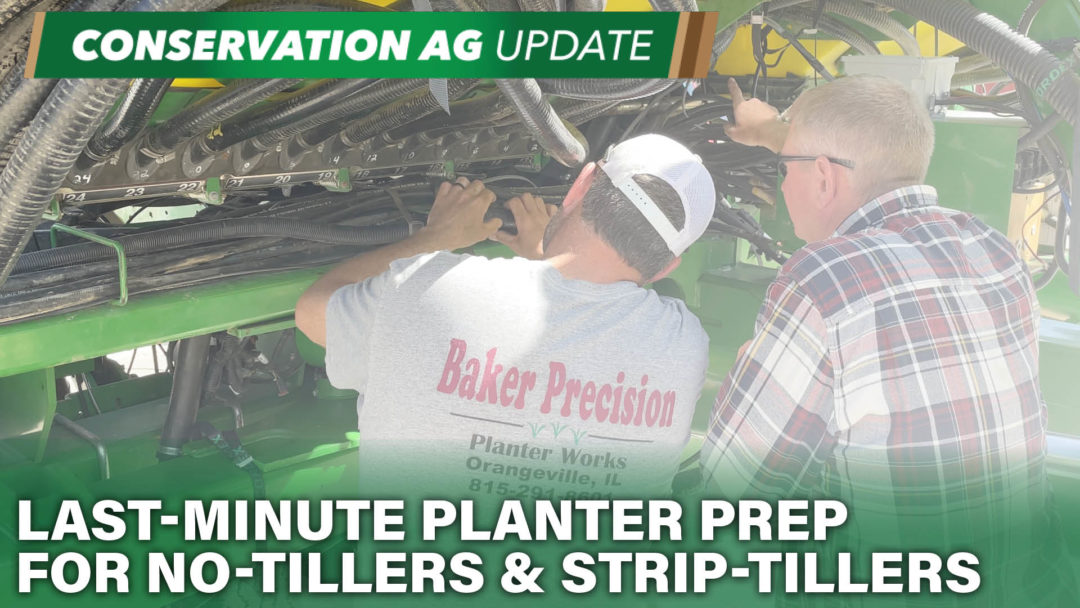On this episode of Conservation Ag Update, brought to you by Martin-Till, precision specialist Chad Baker, co-owner of Baker Precision Planter Works in Orangeville, Ill., helps a first-generation no-tiller with planter setup, and later encounters a couple problems with a strip-tiller’s new 24-row planter. Plus, veteran agronomist Brad Forkner checks in with a couple tips for farmers to keep in mind before they take the field.
In the Cover Crop Connection, a cover cropper expresses safety concerns with a FAA regulatory exemption that will allow a single person to operate a swarm of heavy-lift drones.
Plus, 2024 Strip-Till Innovator Chris Perkins shares his formula for a 300-bushel corn yield and breaks down the true value of residue. Finally, in the Video of the Week, Conservation Technology Information Center executive director Ryan Heiniger shows why, “We have a major soil erosion criss in this country that is absolutely destroying the future generation’s ability to grow food, fuel and fiber.”
This episode of Conservation Ag Update is brought to you by Martin-Till.
Our customers believe that Martin-Till®️ products provide an excellent return on their investment. We know this because a large percentage of them are repeat customers since the beginning in 1991. Our planter attachments help make it possible to plant into higher levels of residue and moisture. Higher levels of mulch means less erosion, improved soil tilth and fertility, which can reduce production costs.
Martin-Till’s goal is to increase yields and save you time and money. We hope you find something from our product offerings of row cleaner, UMO’s, closing wheels systems and recently added concaves that will make this year’s planting & harvesting go better for you. After all, you deserve the best!
TRANSCRIPT
Jump to a section or scroll for the full episode...
- #Plant24: No-Tillers & Strip-Tillers Make Last-Minute Adjustments
- Pre-Season Advice from Veteran Agronomist Brad Forkner
- New FAA Exemption: Efficiency Boost or Safety Hazard?
- Banded Systems: 300 Bushels & Beyond
- Video of the Week: Major Erosion Crisis
#Plant24: No-Tillers & Strip-Tillers Make Last-Minute Adjustments
Welcome to Conservation Ag Update! Corn planting is underway in 13 of the top 18 corn-growing states with 6% of acres planted nationwide, according to the April 14th 2024 USDA Crop Progress Report. Soybeans are 3% planted. It’s crunch time as many farmers make those last-minute preparations for #Plant24, as the kids say.
Let’s head out to Warren, Ill., where first-generation no-tiller Andy Beyer is making sure his planter is ready to go. After some heavy rainfall, he’s waiting for soil conditions to “settle a bit” before he starts no-tilling corn and soybeans.
His precision specialist, Chad Baker, stops by for a pre-season checkup. The John Deere 1770NT looks fine at first glance, but they decide to fill it with seed and take it to a neighboring field just to make sure there are no gremlins lurking. Everything checks out OK.
Chad gives him this new tool to try out — it locks up the closer and allows Andy to check seed depth.
Chad then heads down the road to strip-tiller Don Brinkmeier, who has his hands full with a new 24-row, high-speed planter with all the precision bells and whistles including FurrowForce and vApply HD on every row. They quickly find a hole in one of the hoses and discover that the starter fertilizer pump isn’t working.
Chad eventually gets to the bottom of it and fixes the problem. Crisis averted. Don can sleep a little bit better tonight knowing he caught these time bombs.
“The support I get from Chad, it’s just hard not to have somebody like him around. Anytime you call, he can talk you through it on the phone, or when he’s here, he can figure out any problem I have. He’s very good at it — better than he knows.”
– Don Brinkmeier, Strip-Tiller, Warren, Ill.
“Make sure you check everything. Check your measurements. Make sure everything is working. Don’t think just because you put it away that it’s going to work. Get out, check it. Do your pre-trips. Check your measurements, your maintenance. Do all that stuff because when you’re ready to go, you just want to go. You don’t want to work on things.
“You find a lot of wiring, hook ups or a guy buys a new planter and maybe it wasn’t wired correctly from the customer before. So, you just find a lot of the pain points and alleviate them now before we all get really busy.”
– Chad Baker, Co-Owner, Baker Precision Planter Works
Pre-Season Advice from Veteran Agronomist Brad Forkner
For more pre-season advice, I caught up with veteran agronomist Brad Forkner. The nutrient management specialist has a few tips for no-tillers, especially if it’s their first year using biologicals.
“Remember biology is a living thing. And all biology has a heat range they can live in. If you get this stuff, and you’re going to have it put in before you go to the field, please keep those tanks inside. Please remember it’s a living organism. They do need oxygen. If you plug a screen, figure it out really quick. Maybe we need to stop and not do any of that before we plug the whole thing up. Nobody wants to go out there the next morning and get a call that says I now have 36 rows in my planter that somebody needs to clean up. Let’s have discussions on the front end. What’s in there, why it’s in there and how do we handle it.”
Brad Forkner will be sharing more insights at the 2024 National Strip-Tillage Conference Aug. 8 in Madison, Wis. Head to StripTillConference.com to reserve your spot. Now let’s see what’s going on in the world of cover crops.
New FAA Exemption: Efficiency Boost or Safety Hazard?
The Federal Aviation Administration recently granted a regulation exemption that will allow 1 person to operate 3 drones in a swarm. While some see this as a big win from a productivity standpoint since it has the potential to make cover crop drone seeing more efficient, others see it as a massive safety concern. Here’s Watertown, Wis., crop and livestock management consultant John Pernat sharing his first-hand experience of why he’s not so sure it’s a good idea.
“I’ve been in the agricultural field my whole life. From power washing equipment back in the day, to loading hay — physically demanding work. Hold this for 10 hours, knowing that if you screw up, it’s not going to be a good day. The mental aspect of flying one of these — and I’m no genius by any means — but the responsibility that is wearing on you all day, between you and your co-pilot or you and your neighbor is actually more physically demanding than bailing hay. I’d rather unload hay for 18 hours than operate 3 of these at once. I’ve done 2 of these at once just as a training. No way will I ever do 3. It’s foolish to even think about it. So, 1 Guy in the field, trying to operate 3 of these without a co-pilot, trying to keep 3 of these fed, you’re just asking for trouble. I just feel it’s unnecessary. 2 of these out there flying at once, we’ll back the acre rate down, that’s 80 acres an hour, plus moving, plus liquid, plus keeping track of your chemicals, plus the paperwork. I like the idea, but I will not run after having the experience last year of having a pilot pass out. Now you have 2 of these out there with 1 guy and nobody to take care of him? And they’re out there hovering around? I don’t like that safety idea.”
While the new regulation exemption has the potential to make seeding cover crops with drones more efficient, Pernat brings up valid concerns about safety. And if you have your own thoughts on the issue, we’d love to hear them so feel free to send us a message.
Banded Systems: 300 Bushels & Beyond
Shifting gears now to our 2024 Strip-Till Innovator Award recipient…drumroll…it’s Chris Perkins, from Otwell, Ind. Let’s take a quick look at his journey and the impact he’s having in the strip-till world.
Catch the rest of the story at StripTillFarmer.com, as Chris dives deeper into his strip-till equipment and nutrient management strategies.
Video of the Week: Major Erosion Crisis
Let’s wrap things up with our Video the Week, coming to us from Iowa native Ryan Heiniger, who’s the executive director of the Conservation Technology Information Center.
He posted these videos of runoff on X, formerly known as Twitter. “There is no joy in a post like this,” he says. “Zero. It isn’t about one way of farming vs. another. But let’s not pretend it is a few bad apples. We have a major soil erosion crisis in this country that is absolutely destroying the future generation’s ability to grow food, fuel and fiber.”
Wisconsin no-tiller Adam Lasch responded to Ryan’s post with this: “The social license to farm ‘any way I like!’ is going to be revoked. Public will and tolerance are eroding, and it’s time to acknowledge it. It’s just a matter of time now.”
That will wrap things up. Have an interesting photo or video from your farm? Or a story you’d like us to feature on the broadcast? Send me an email at Nnewman@lesspub.com.
And that will wrap things up this edition of Conservation Ag Update. Until next time, for more stories visit no-tillfarmer.com, striptillfarmer.com and covercropstrategies.com. Thanks for stopping by. Have a great day!









Post a comment
Report Abusive Comment